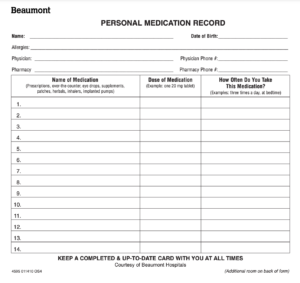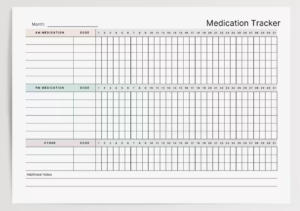In today’s healthcare landscape, juggling multiple providers and medications has become the norm. A Personal Medication Record (PMR) emerges as a crucial tool in this complexity, offering a streamlined way for patients to keep their medication regimens in check.
Not only does it facilitate seamless coordination, but it also provides a vital record for pharmacists and doctors to analyze, ensuring the most accurate and effective treatment decisions. A PMR is more than just a list; it’s a key to better, safer healthcare.
We’ll uncover its multifaceted role in enhancing your health management and ensuring the efficacy and safety of your treatments. Continue with us as we explore how a Personal Medication Record becomes an essential part of your healthcare toolkit.
What Is a Personal Medication Record (PMR)?
A Personal Medication Record (PMR), also known as a medication record sheet or personal medicine form, is a specially formatted document for individuals to track their health and medications.

It helps keep track of all prescription drugs, over-the-counter medications, and dietary supplements, including information such as dosages, characteristics of the medications, instructions for use, reasons for the prescription, and doctor’s details.
Additionally, a medication record keeper can encompass dietary specifics and other pertinent health information, offering a more comprehensive view of your overall health status.
Who Needs to Use a PMR?
Typically, the use of a PMR is beneficial for a wide range of individuals, particularly:
- Patients with Chronic Conditions: Individuals managing chronic conditions like diabetes, hypertension, heart disease, and asthma benefit greatly from maintaining a PMR. It helps in managing complex medication schedules and ensures that healthcare providers are aware of all the medications being taken to avoid potential drug interactions.
- Older Adults: Older adults often take multiple medications to manage various health issues. A PMR is crucial for them to manage their medications effectively, especially since they are more susceptible to medication side effects and interactions.
- Individuals Seeing Multiple Healthcare Providers: People who consult with multiple healthcare providers, including specialists, need a PMR to ensure that all their providers are aware of their complete medication regimen. This coordination helps in avoiding prescription overlaps, under-treatment, or dangerous drug interactions.
- Caregivers: Caregivers of dependent individuals, whether the elderly, children with health conditions, or disabled persons, use PMRs to track medication schedules and communicate effectively with healthcare professionals about the care recipient’s needs.
- Patients Undergoing Surgery or Hospitalization: Before undergoing any surgical procedure or hospitalization, patients are often asked about the medications they are taking. A PMR provides accurate and up-to-date information, which is crucial for avoiding complications during and after the procedure.
- Travelers: Individuals traveling, especially those going abroad, benefit from having a PMR. It serves as a crucial document in case of a medical emergency away from home and can help healthcare professionals in another country understand their medication history.
- Anyone Managing Multiple Medications: Even those without chronic conditions but who are taking multiple medications for acute conditions, such as infections or temporary pain management, find a PMR useful for tracking their medication schedules and ensuring safety.
The Role of a Pharmacist in PMRs
Pharmacists are responsible for recommending the use of a PMR and keeping it updated.
They provide the document and fill the record with all relevant information like medication names, dosages, indications, administration schedules, and duration of treatment. However, sometimes, patients themselves can be the ones filling out the record in the beginning, with the help of the pharmacist.
This comprehensive digital or physical document is meant to help you as a pharmacist in monitoring medication therapy, identifying potential interactions, and making informed decisions about medication adjustments.
Pharmacists should guide patients in maintaining their PMR, ensuring it remains a reliable tool for effective pharmacotherapy management.
Creating A Personal Medication Record (PMR) Format
To begin providing Personal Medication Records to your patients, you simply need to download the “My Medicine Record” document from the Food and Drug Administration (FDA). This readily available resource is designed to help you facilitate effective medication management for your patients.
This is the most comprehensive personal medication record template and is recommended for any first-time user. It includes the main table where patients will input their information. It also includes instructions on how to use the document as well as questions you need to ask when reviewing it.
The Components of a Personal Medication Record
Depending on the source, personal medication records can vary, but these are the most important components you can find.
Medicine Chart or Medication Chart
This is the principal section your patient will be using. In this chart, they have to input all information about their medications and dietary supplements.
In the case of My Medicine Record, the fields you can find include the name of the medicine or supplement, what it looks like, dosage, instructions of use, start and stop dates, explanation, notes, and the prescribing doctor’s contact details.
Personal Information Sheet
This part is used to record essential information such as pharmacy contacts, emergency contacts, and important questions for healthcare professionals.
Not only that but there are two critical sections to fill out. The first one is the place where they have to detail any allergic reaction or problem they’ve had with a specific medicine, supplement, or product.
The other one is for mentioning any medical conditions and operations they’ve had. All of this will give you the complete picture before you can make any decisions about their treatments.
Instructions and Guidelines
The following pages of the document provide help with recording medicines and supplements, ensuring that the record is kept accurate and up-to-date.
Here, you can find the explanation for every field in this document in case something is not clear to the patient.
Benefits of Using a Personal Medication Record
There are many benefits to recording medication history. Some include:
Safer medication consumption
A PMR helps avoid medication errors, such as duplications, interactions, and incorrect dosages. For example, since people are tracking dosage and visual characteristics of the medicine, they won’t take the wrong amount or pill. They can just look back at their personal medication record and verify.
Better doctor-patient communication
A medication record sheet facilitates clear communication between different healthcare providers, ensuring everyone is aware of the patient’s medication regimen, allergies, conditions, and more.
Emergency preparedness
In emergencies where the patient is incapable of communicating with the medical staff, a PMR provides quick access to vital medication information, which can be lifesaving.
Better health management
PMRs help in tracking medications’ effectiveness and side effects, supporting more informed healthcare decisions.
Growth opportunity for pharmacies
PMRs are great tools for patients, but not many people know about them. You can start offering this document in addition to medication therapy management services to increase patient engagement and potentially revenue.
How to Use a Personal Medication Record
The process of using a personal medication record is straightforward. Most PMR formats include instructions to use.
- Gathering Information: Patients and their pharmacists/doctors should collect all medication details, including prescriptions, over-the-counter drugs, and supplements. Also, keep in mind any allergies, conditions, and medical procedures over the years.
- Format decision: Decide whether to use a digital tool or a physical document like the “My Medicine Record” PDF. Digital records are easily updated and shared, while physical copies are useful in emergencies when digital access may not be possible. Then give the format of choice to your patient.
- Filling in the details: Now, the pharmacist needs to record all necessary information for each medication: name, dosage, purpose, prescribing doctor, and any special instructions on a med tracking sheet or medication record sheet.
- Updating: The record should then be updated regularly following any changes in treatment.
Improve Adherence With a Medication Tracker Chart
Another great addition to a PMR is a medicine tracker chart.
These might sound similar, but the difference is that a PMR is for general information about the medication being taken, while the tracking chart helps with staying consistent.
In the tracking chart, the patient would write down the day and hour they take their medicine, especially their prescriptions. They can also use it to write any notes relevant to each dose.
This chart allows for a visual representation of the patient’s medication schedule.
It can be incorporated into their existing PMR as a med tracking sheet, offering a quick reference and helping to ensure adherence to the medication regimen.
Give Your Patients the Best Service
Medical adherence is a huge problem for individuals.
In addition, it’s not uncommon for people to make mistakes when taking their medications, like confusing different pills or taking a different dosage.
Communication between patients and healthcare providers is not perfect either. Simply not knowing about an allergy or previous procedure could result in adverse effects for the patient.
Personal medication records are a great tool to help with these issues, but most people don’t know about them.
As a pharmacist or doctor, you can provide a better service and ensure positive outcomes by informing patients about this resource. Keeping a record will allow the patient’s healthcare providers to always make the best decisions.
Want to start offering PMRs and clinical services like medication therapy management in your pharmacy? DocStation can help you. Send us a message to learn more.






